warning MITSUBISHI ECLIPSE CROSS 2020 (in English) Service Manual
[x] Cancel search | Manufacturer: MITSUBISHI, Model Year: 2020, Model line: ECLIPSE CROSS, Model: MITSUBISHI ECLIPSE CROSS 2020Pages: 427, PDF Size: 78.05 MB
Page 164 of 427
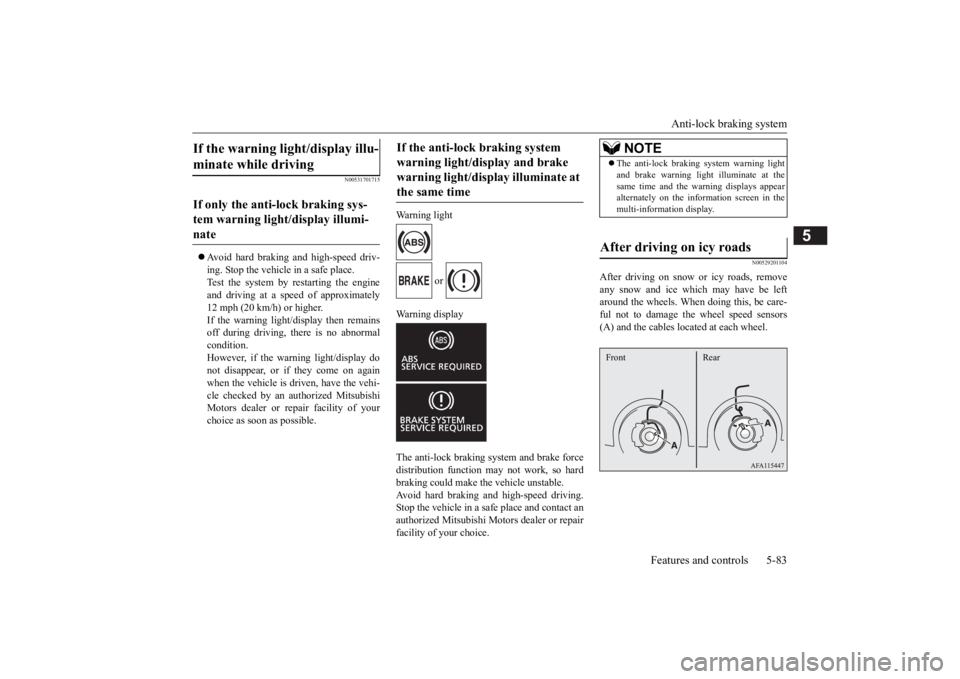
Anti-lock braking system
Features and controls 5-83
5
N00531701715
Avoid hard braking and high-speed driv-
ing. Stop the vehicle in a safe place.
Test the system by restarting the engine
and driving at a speed of approximately
12 mph (20 km/h) or higher.
If the warning light/display then remains
off during driving, there is no abnormal
condition.
However, if the warning light/display do
not disappear, or if they come on again
when the vehicle is driven, have the vehi-
cle checked by an authorized Mitsubishi
Motors dealer or repair facility of your
choice as soon as possible. Warning light
or
Warning display
The anti-lock braking system and brake force
distribution function may not work, so hard
braking could make the vehicle unstable.
Avoid hard braking and high-speed driving.
Stop the vehicle in a safe place and contact an
authorized Mitsubishi Motors dealer or repair
facility of your choice.
N00529201104
After driving on snow or icy roads, remove
any snow and ice which may have be left
around the wheels. When doing this, be care-
ful not to damage the wheel speed sensors
(A) and the cables located at each wheel.
If the warning light/display illu-
minate while driving If only the anti-lock braking sys-
tem warning light/display illumi-
nate
If the anti-lock braking system
warning light/display and brake
warning light/display illuminate at
the same time
NOTE
The anti-lock braking system warning light
and brake warning light illuminate at the
same time and the warning displays appear
alternately on the information screen in the
multi-information display.After driving on icy roads Front Rear
BK0277700US.book 83 ページ 2019年3月12日 火曜日 午前9時34分
Page 165 of 427
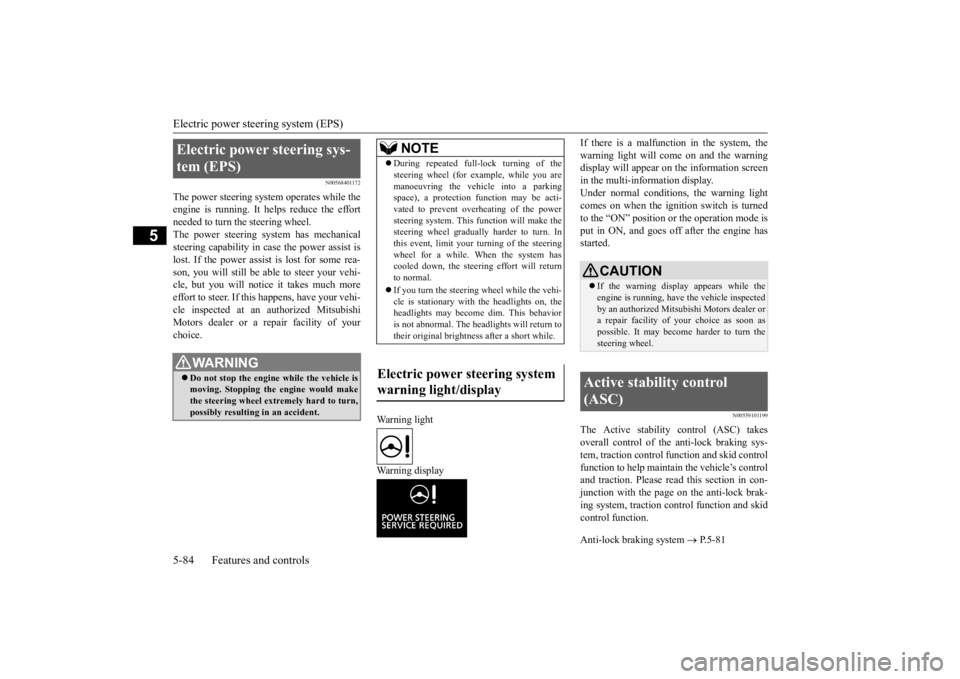
Electric power steering system (EPS) 5-84 Features and controls
5
N00568401172
The power steering system operates while the engine is running. It helps reduce the effortneeded to turn the steering wheel. The power steering system has mechanical steering capability in case the power assist islost. If the power assist is lost for some rea- son, you will still be able to steer your vehi- cle, but you will notice it takes much moreeffort to steer. If this happens, have your vehi-cle inspected at an authorized Mitsubishi Motors dealer or a repair facility of your choice.
Warning light Warning display
If there is a malfunction in the system, the warning light will come on and the warning display will appear on the information screen in the multi-information display.Under normal conditions, the warning light comes on when the ignition switch is turned to the “ON” position or the operation mode isput in ON, and goes off after the engine has started.
N00559101199
The Active stability control (ASC) takesoverall control of the anti-lock braking sys- tem, traction control function and skid controlfunction to help maintain the vehicle’s control and traction. Please read
this section in con-
junction with the page on the anti-lock brak-ing system, traction control function and skid control function. Anti-lock braking system
P.5-81
Electric power steering sys- tem (EPS)
WA R N I N G Do not stop the engine while the vehicle is moving. Stopping the engine would make the steering wheel extremely hard to turn,possibly resulting in an accident.
NOTE
During repeated full-lock turning of the steering wheel (for example, while you are manoeuvring the vehicle into a parking space), a protection function may be acti- vated to prevent overheating of the powersteering system. This function will make the steering wheel gradually harder to turn. In this event, limit your
turning of the steering
wheel for a while. When the system has cooled down, the steering effort will return to normal. If you turn the steering wheel while the vehi- cle is stationary with the headlights on, theheadlights may become dim. This behavior is not abnormal. The headlights will return to their original brightness after a short while.
Electric power steering system warning light/display
CAUTION If the warning display appears while the engine is running, have the vehicle inspected by an authorized Mitsubishi Motors dealer or a repair facility of
your choice as soon as
possible. It may become harder to turn the steering wheel.
Active stability control (ASC)
BK0277700US.bo
ok 84 ページ 2019年3月8日 金曜日 午前9時23分
Page 166 of 427
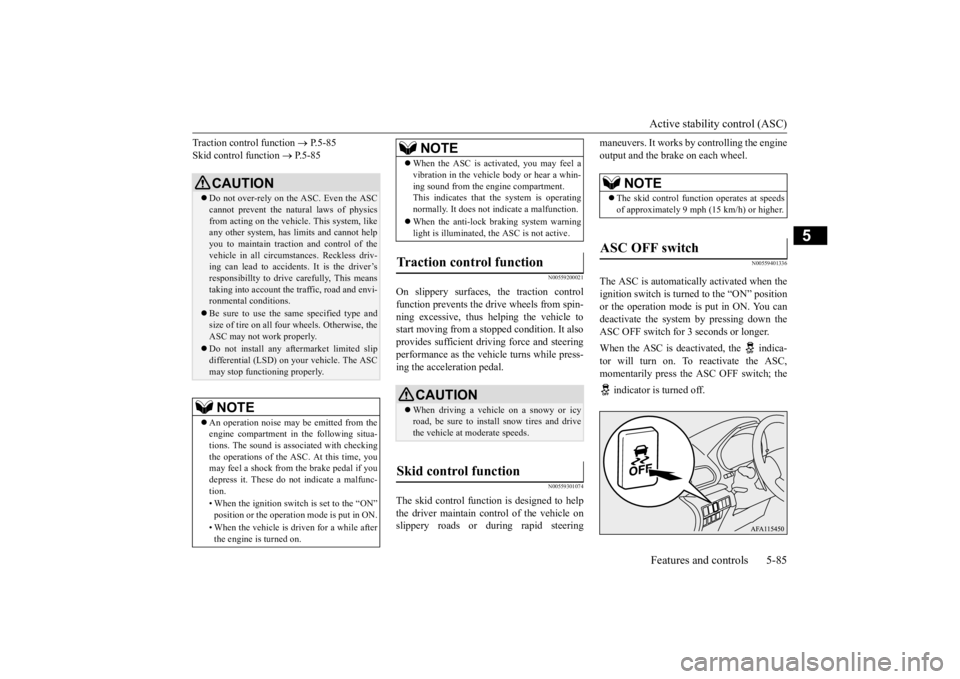
Active stability control (ASC) Features and controls 5-85
5
Traction control function
P.5-85
Skid control function
P.5-85
N00559200021
On slippery surfaces, the traction control function prevents the drive wheels from spin-ning excessive, thus helping the vehicle to start moving from a stopped condition. It also provides sufficient driving force and steeringperformance as the vehicle turns while press- ing the acceleration pedal.
N00559301074
The skid control function is designed to help the driver maintain control of the vehicle onslippery roads or during rapid steering
maneuvers. It works by controlling the engine output and the brake on each wheel.
N00559401336
The ASC is automatically activated when theignition switch is turned to the “ON” positionor the operation mode is put in ON. You can deactivate the system by pressing down the ASC OFF switch for 3 seconds or longer. When the ASC is deactivated, the indica- tor will turn on. To reactivate the ASC, momentarily press the ASC OFF switch; the indicator is turned off.
CAUTION Do not over-rely on the ASC. Even the ASC cannot prevent the natural laws of physics from acting on the vehicl
e. This system, like
any other system, has limits and cannot help you to maintain traction and control of the vehicle in all circumstances. Reckless driv-ing can lead to accidents. It is the driver’s responsibillty to drive carefully, This means taking into account the traffic, road and envi-ronmental conditions. Be sure to use the same specified type and size of tire on all four wheels. Otherwise, the ASC may not work properly. Do not install any aftermarket limited slip differential (LSD) on your vehicle. The ASC may stop functioning properly.NOTE
An operation noise may be emitted from the engine compartment in the following situa- tions. The sound is associated with checking the operations of the ASC. At this time, you may feel a shock from the brake pedal if youdepress it. These do not indicate a malfunc- tion. • When the ignition switch is set to the “ON” position or the operation mode is put in ON. • When the vehicle is driven for a while after the engine is turned on.
When the ASC is activated, you may feel a vibration in the vehicle body or hear a whin- ing sound from the engine compartment. This indicates that the system is operating normally. It does not indicate a malfunction. When the anti-lock braking system warning light is illuminated, the ASC is not active.
Traction control function
CAUTION When driving a vehicle on a snowy or icy road, be sure to install snow tires and drivethe vehicle at moderate speeds.
Skid control function
NOTE
NOTE
The skid control function operates at speeds of approximately 9 mph (15 km/h) or higher.
ASC OFF switch
BK0277700US.bo
ok 85 ページ 2019年3月8日 金曜日 午前9時23分
Page 167 of 427
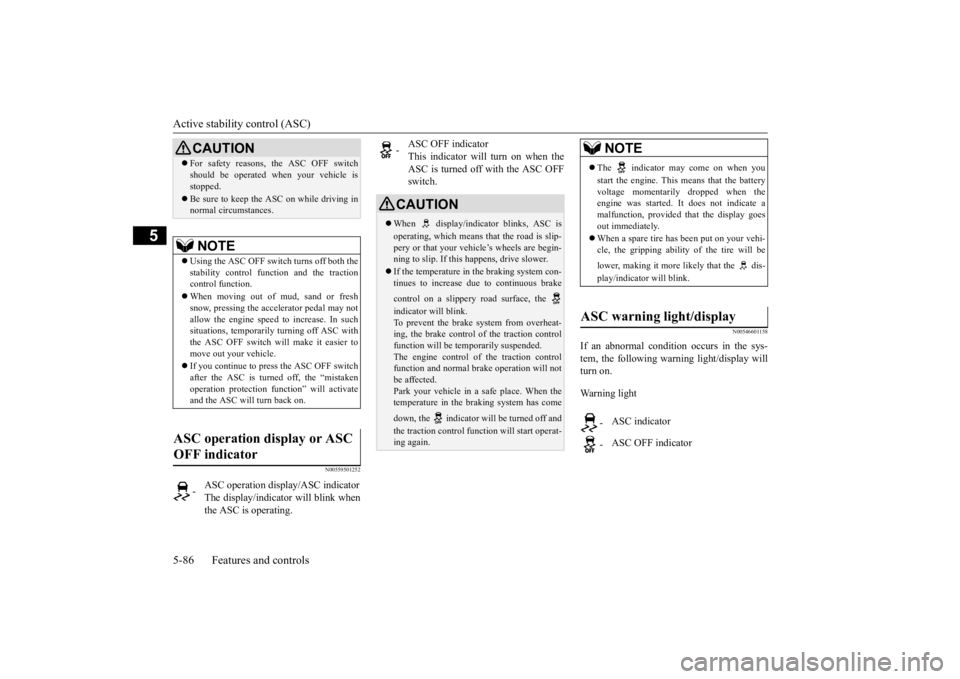
Active stability control (ASC) 5-86 Features and controls
5
N00559501252
N00546601158
If an abnormal condition occurs in the sys- tem, the following warning light/display will turn on. Warning light
CAUTION For safety reasons, the ASC OFF switch should be operated when your vehicle is stopped. Be sure to keep the ASC on while driving in normal circumstances.NOTE
Using the ASC OFF switch turns off both the stability control function and the tractioncontrol function. When moving out of mud, sand or fresh snow, pressing the accelerator pedal may not allow the engine speed to increase. In such situations, temporarily turning off ASC withthe ASC OFF switch will make it easier to move out your vehicle. If you continue to press the ASC OFF switch after the ASC is turned off, the “mistaken operation protection function” will activateand the ASC will turn back on.
ASC operation display or ASC OFF indicator
-
ASC operation display/ASC indicator The display/indicator will blink whenthe ASC is operating.
-
ASC OFF indicator This indicator will turn on when theASC is turned off with the ASC OFF switch.
CAUTION When display/indicator blinks, ASC is operating, which means that the road is slip- pery or that your vehicle’s wheels are begin-ning to slip. If this happens, drive slower. If the temperature in the braking system con- tinues to increase due to continuous brake control on a slippery road surface, the indicator will blink. To prevent the brake system from overheat-ing, the brake control of the traction control function will be temporarily suspended. The engine control of the traction controlfunction and normal brake operation will not be affected. Park your vehicle in a safe place. When thetemperature in the braking system has come down, the indicator will be turned off and the traction control function will start operat- ing again.
NOTE
The indicator may come on when you start the engine. This means that the battery voltage momentarily dropped when the engine was started. It does not indicate amalfunction, provided that the display goes out immediately. When a spare tire has been put on your vehi- cle, the gripping ability of the tire will be lower, making it more likely that the dis- play/indicator will blink.
ASC warning light/display
-
ASC indicator
-
ASC OFF indicator
BK0277700US.bo
ok 86 ページ 2019年3月8日 金曜日 午前9時23分
Page 168 of 427
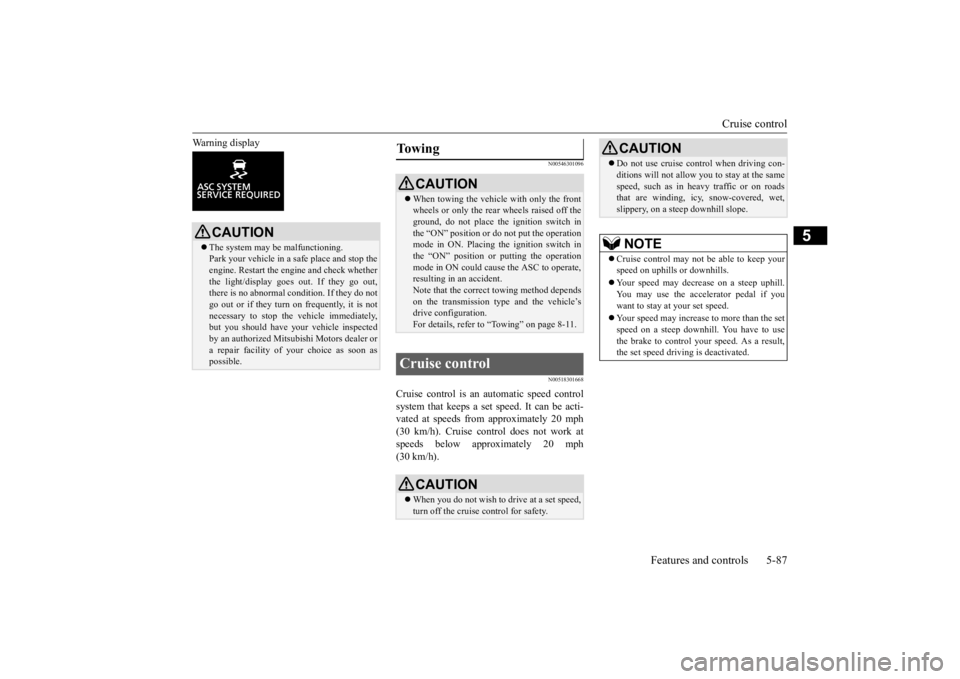
Cruise control
Features and controls 5-87
5
Warning display
N00546301096 N00518301668
Cruise control is an automatic speed control system that keeps a set speed. It can be acti- vated at speeds from approximately 20 mph(30 km/h). Cruise control does not work at speeds below approximately 20 mph (30 km/h).
CAUTION The system may be malfunctioning. Park your vehicle in a safe place and stop theengine. Restart the engine and check whether the light/display goes out. If they go out, there is no abnormal condition. If they do notgo out or if they turn on frequently, it is not necessary to stop the vehicle immediately, but you should have your vehicle inspectedby an authorized Mitsubishi Motors dealer or a repair facility of
your choice as soon as
possible.
To w i n g
CAUTION When towing the vehicle with only the front wheels or only the rear wheels raised off the ground, do not place the ignition switch in the “ON” position or do not put the operationmode in ON. Placing the ignition switch in the “ON” position or putting the operation mode in ON could cause the ASC to operate,resulting in an accident. Note that the correct towing method depends on the transmission type and the vehicle’sdrive configuration. For details, refer to “Towing” on page 8-11.
Cruise control
CAUTION When you do not wish to drive at a set speed, turn off the cruise control for safety.
Do not use cruise control when driving con- ditions will not allow you to stay at the same speed, such as in heavy traffic or on roads that are winding, icy, snow-covered, wet, slippery, on a steep downhill slope.NOTE
Cruise control may not be able to keep your speed on uphills or downhills. Your speed may decrease on a steep uphill. You may use the accelerator pedal if you want to stay at your set speed. Your speed may increase to more than the set speed on a steep downhill. You have to use the brake to control your speed. As a result,the set speed driving is deactivated.CAUTION
BK0277700US.bo
ok 87 ページ 2019年3月8日 金曜日 午前9時23分
Page 177 of 427
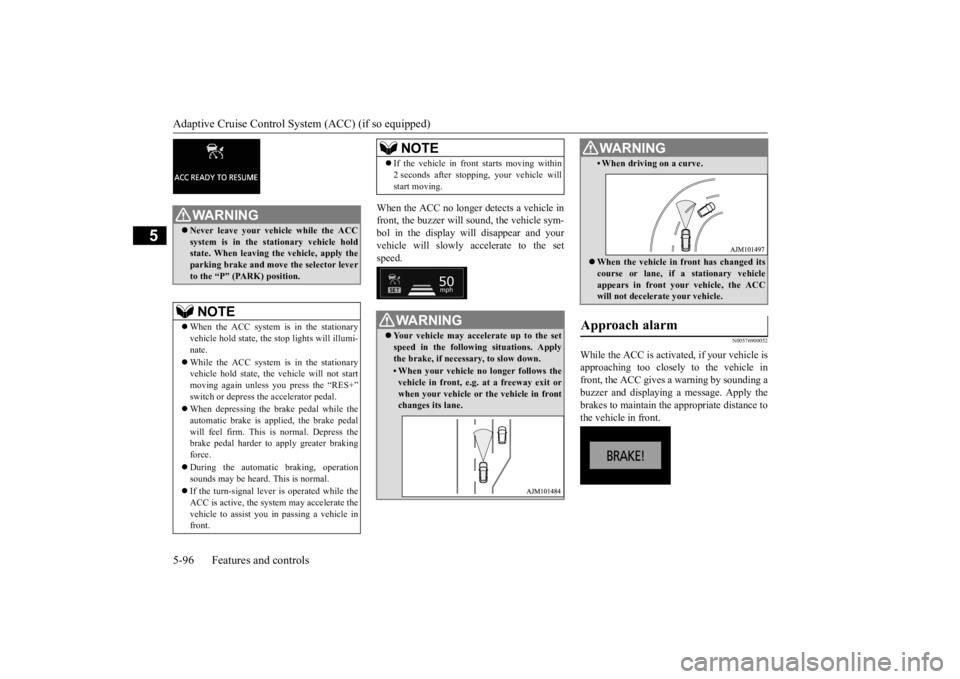
Adaptive Cruise Control System (ACC) (if so equipped) 5-96 Features and controls
5
When the ACC no longer detects a vehicle in front, the buzzer will sound, the vehicle sym- bol in the display will disappear and your vehicle will slowly accelerate to the setspeed.
N00576900052
While the ACC is activated, if your vehicle isapproaching too closely to the vehicle infront, the ACC gives a warning by sounding a buzzer and displaying a message. Apply the brakes to maintain the appropriate distance tothe vehicle in front.
WA R N I N G Never leave your vehicle while the ACC system is in the stationary vehicle hold state. When leaving the vehicle, apply the parking brake and move the selector leverto the “P” (PARK) position.NOTE
When the ACC system is in the stationary vehicle hold state, the stop lights will illumi-nate. While the ACC system is in the stationary vehicle hold state, the vehicle will not start moving again unless you press the “RES+” switch or depress the accelerator pedal. When depressing the brake pedal while the automatic brake is applied, the brake pedalwill feel firm. This is normal. Depress the brake pedal harder to apply greater braking force. During the automatic braking, operation sounds may be heard. This is normal. If the turn-signal lever is operated while the ACC is active, the system may accelerate the vehicle to assist you in passing a vehicle in front.
If the vehicle in front starts moving within 2 seconds after stopping, your vehicle will start moving.WA R N I N G Your vehicle may accelerate up to the set speed in the following situations. Apply the brake, if necessary, to slow down.• When your vehicle no longer follows thevehicle in front, e.g. at a freeway exit or when your vehicle or the vehicle in frontchanges its lane.NOTE
• When driving on a curve. When the vehicle in front has changed its course or lane, if a stationary vehicle appears in front your vehicle, the ACC will not decelerate your vehicle.
Approach alarm
WA R N I N G
BK0277700US.bo
ok 96 ページ 2019年3月8日 金曜日 午前9時23分
Page 182 of 427
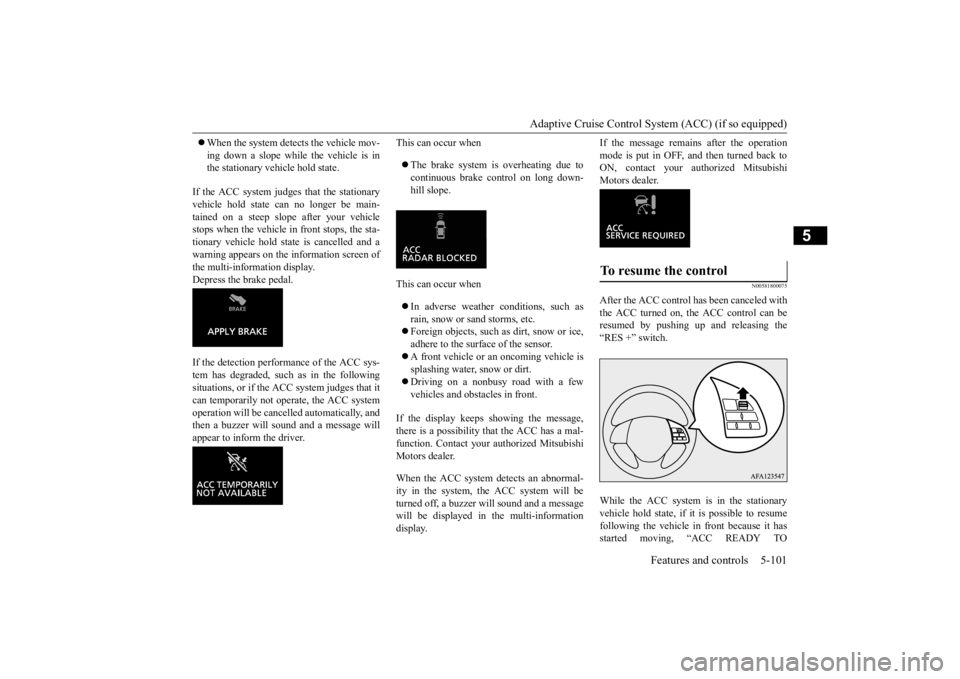
Adaptive Cruise Control System (ACC) (if so equipped)
Features and controls 5-101
5
When the system detects the vehicle mov- ing down a slope while the vehicle is in the stationary vehicle hold state.
If the ACC system judges that the stationary vehicle hold state can no longer be main-tained on a steep slope after your vehicle stops when the vehicle in front stops, the sta- tionary vehicle hold state is cancelled and awarning appears on the information screen of the multi-information display. Depress the brake pedal. If the detection performance of the ACC sys- tem has degraded, such as in the following situations, or if the ACC system judges that it can temporarily not operate, the ACC systemoperation will be cancelled automatically, and then a buzzer will sound and a message will appear to inform the driver.
This can occur when The brake system is overheating due to continuous brake control on long down- hill slope.
This can occur when In adverse weather
conditions, such as
rain, snow or sand storms, etc. Foreign objects, such as dirt, snow or ice, adhere to the surface of the sensor. A front vehicle or an oncoming vehicle is splashing water, snow or dirt. Driving on a nonbusy road with a few vehicles and obstacles in front.
If the display keeps showing the message, there is a possibility
that the ACC has a mal-
function. Contact your authorized Mitsubishi Motors dealer. When the ACC system detects an abnormal- ity in the system, the ACC system will beturned off, a buzzer will sound and a message will be displayed in the multi-information display.
If the message remains after the operation mode is put in OFF, and then turned back to ON, contact your authorized Mitsubishi Motors dealer.
N00581800075
After the ACC control has been canceled withthe ACC turned on, the ACC control can beresumed by pushing up and releasing the “RES +” switch. While the ACC system is in the stationary vehicle hold state, if it is possible to resume following the vehicle in front because it has started moving, “ACC READY TOTo resume the control
BK0277700US.book
101 ページ 2019年3月8日 金曜日 午前9時23分
Page 185 of 427
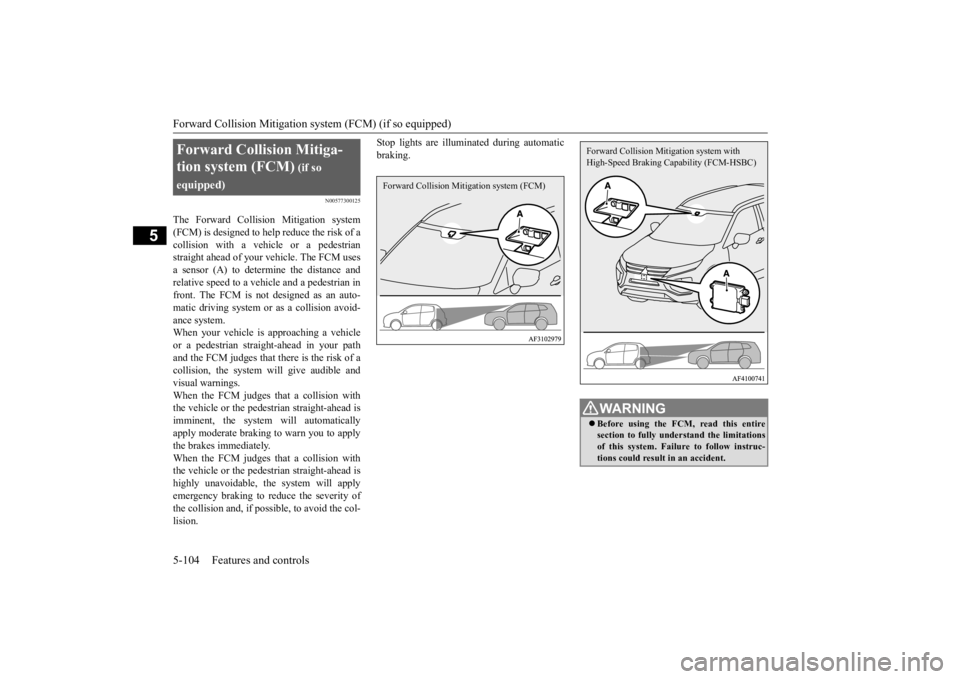
Forward Collision Mitigation system (FCM) (if so equipped)
5-104 Features and controls
5
N00577300125
The Forward Collision Mitigation system
(FCM) is designed to help reduce the risk of a
collision with a vehicle or a pedestrian
straight ahead of your vehicle. The FCM uses
a sensor (A) to determine the distance and
relative speed to a vehicle and a pedestrian in
front. The FCM is not designed as an auto-
matic driving system or as a collision avoid-
ance system.
When your vehicle is approaching a vehicle
or a pedestrian straight-ahead in your path
and the FCM judges that there is the risk of a
collision, the system will give audible and
visual warnings.
When the FCM judges that a collision with
the vehicle or the pedestrian straight-ahead is
imminent, the system will automatically
apply moderate braking to warn you to apply
the brakes immediately.
When the FCM judges that a collision with
the vehicle or the pedestrian straight-ahead is
highly unavoidable, the system will apply
emergency braking to reduce the severity of
the collision and, if possible, to avoid the col-
lision. Stop lights are illuminated during automatic
braking.Forward Collision Mitiga-
tion system (FCM)
(if so
equipped)
Forward Collision Mitigation system (FCM)
WA R N I N G Before using the FCM, read this entire
section to fully understand the limitations
of this system. Failure to follow instruc-
tions could result in an accident.Forward Collision Mitigation system with
High-Speed Braking Capability (FCM-HSBC)
BK0277700US.book 104 ページ 2019年3月12日 火曜日 午前9時34分
Page 186 of 427
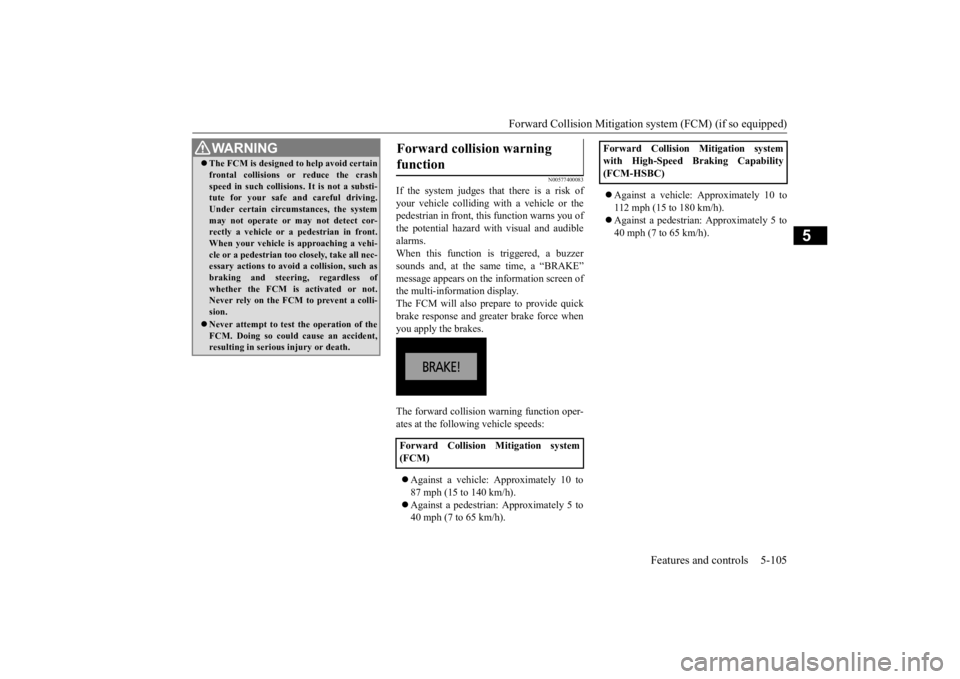
Forward Collision Mitigation sy
stem (FCM) (if so equipped) Features and controls 5-105
5
N00577400083
If the system judges that there is a risk of your vehicle colliding with a vehicle or the pedestrian in front, this function warns you of the potential hazard with visual and audiblealarms. When this function is triggered, a buzzer sounds and, at the same time, a “BRAKE”message appears on the information screen ofthe multi-information display. The FCM will also prepare to provide quick brake response and greater brake force whenyou apply the brakes. The forward collision warning function oper- ates at the following vehicle speeds: Against a vehicle: Approximately 10 to 87 mph (15 to 140 km/h). Against a pedestrian: Approximately 5 to 40 mph (7 to 65 km/h).
Against a vehicle: Approximately 10 to 112 mph (15 to 180 km/h). Against a pedestrian: Approximately 5 to 40 mph (7 to 65 km/h).
The FCM is designed to help avoid certain frontal collisions or reduce the crash speed in such collisions. It is not a substi- tute for your safe and careful driving. Under certain circumstances, the systemmay not operate or may not detect cor- rectly a vehicle or a pedestrian in front. When your vehicle is approaching a vehi-cle or a pedestrian too closely, take all nec- essary actions to avoid a collision, such as braking and steering, regardless ofwhether the FCM is activated or not. Never rely on the FCM to prevent a colli- sion. Never attempt to test the operation of the FCM. Doing so could cause an accident,resulting in serious injury or death.WA R N I N G
Forward collision warning function
Forward Collision Mitigation system (FCM)
Forward Collision Mitigation system with High-Speed Braking Capability (FCM-HSBC)
BK0277700US.book
105 ページ 2019年3月8日 金曜日 午前9時23分
Page 187 of 427
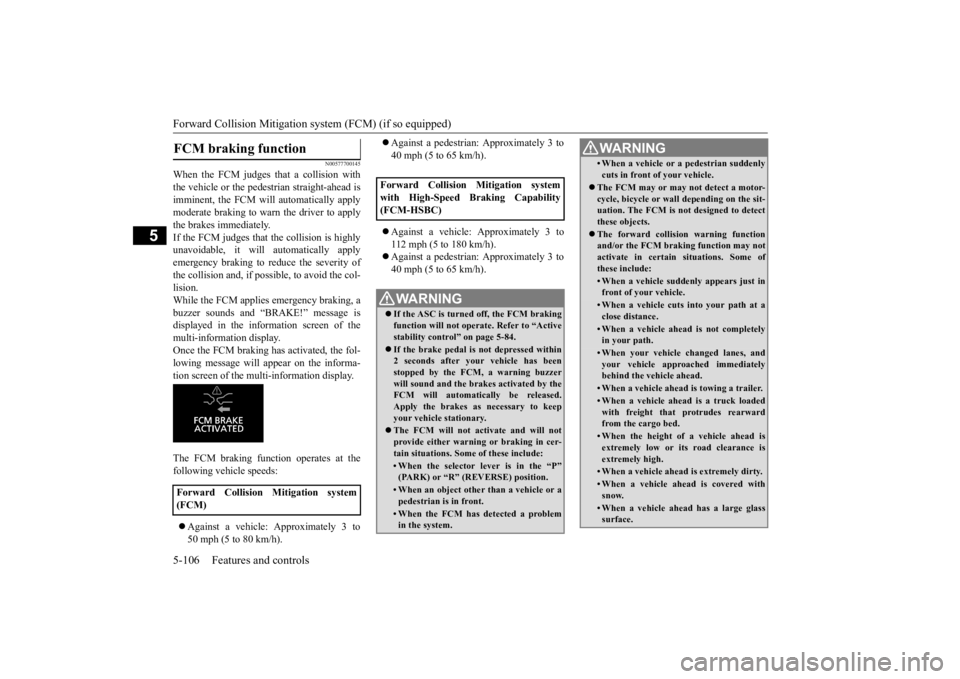
Forward Collision Mitigation sy
stem (FCM) (if so equipped)
5-106 Features and controls
5
N00577700145
When the FCM judges that a collision with the vehicle or the pedestrian straight-ahead isimminent, the FCM will automatically apply moderate braking to warn the driver to apply the brakes immediately.If the FCM judges that the collision is highly unavoidable, it will automatically apply emergency braking to reduce the severity ofthe collision and, if possible, to avoid the col-lision. While the FCM applies emergency braking, a buzzer sounds and “BRAKE!” message isdisplayed in the information screen of the multi-information display. Once the FCM braking has activated, the fol-lowing message will appear on the informa- tion screen of the multi-information display. The FCM braking function operates at the following vehicle speeds: Against a vehicle: Approximately 3 to 50 mph (5 to 80 km/h).
Against a pedestrian: Approximately 3 to 40 mph (5 to 65 km/h). Against a vehicle: Approximately 3 to 112 mph (5 to 180 km/h). Against a pedestrian: Approximately 3 to 40 mph (5 to 65 km/h).
FCM braking function
Forward Collision Mitigation system(FCM)
Forward Collision Mitigation systemwith High-Speed Braking Capability(FCM-HSBC)
WA R N I N G If the ASC is turned off, the FCM braking function will not operate. Refer to “Activestability control” on page 5-84. If the brake pedal is not depressed within 2 seconds after your vehicle has been stopped by the FCM, a warning buzzer will sound and the brakes activated by theFCM will automatically be released. Apply the brakes as necessary to keep your vehicle stationary. The FCM will not activate and will not provide either warning or braking in cer-tain situations. Some of these include:• When the selector lever is in the “P” (PARK) or “R” (REVERSE) position.• When an object other than a vehicle or apedestrian is in front.• When the FCM has detected a problemin the system.
• When a vehicle or a pedestrian suddenlycuts in front of your vehicle.
The FCM may or may not detect a motor- cycle, bicycle or wall depending on the sit-uation. The FCM is not designed to detect these objects. The forward collision warning function and/or the FCM braking function may not activate in certain situations. Some ofthese include:• When a vehicle suddenly appears just infront of your vehicle.• When a vehicle cuts into your path at aclose distance.• When a vehicle ahead is not completelyin your path.• When your vehicle changed lanes, andyour vehicle approached immediately behind the vehicle ahead.• When a vehicle ahead is towing a trailer.• When a vehicle ahead is a truck loaded with freight that protrudes rearward from the cargo bed.• When the height of a vehicle ahead isextremely low or its road clearance is extremely high.• When a vehicle ahead is extremely dirty.• When a vehicle ahead is covered withsnow.• When a vehicle ahead has a large glasssurface.WA R N I N G
BK0277700US.book
106 ページ 2019年3月8日 金曜日 午前9時23分